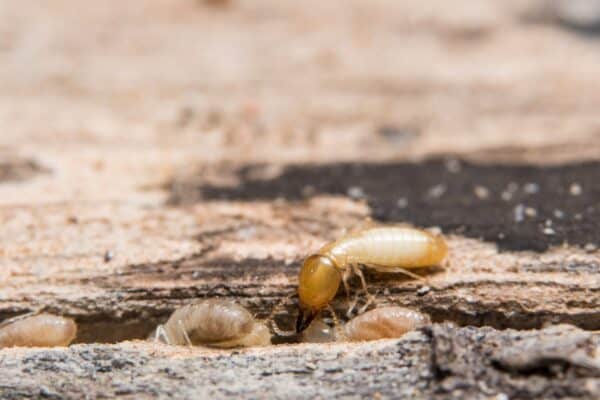Termites are expensive to have, expensive to get rid of, and even expensive to prevent, but ask any homeowner who’s had to deal with them, and they’ll be the first to tell you that they’d rather have spent money upfront to stay away from termite infestations. The truth is, termites cause untold property damage across the United States every year. This isn’t including the mental toll of dealing with termite infestations, mind you.
Understanding how professionals tackle these silent invaders helps homeowners make informed decisions.
Let’s break down the process, from spotting early signs to applying treatments that keep homes safe.

Understanding Termites and Why Treatment Can’t Wait
Before diving into treatment steps, recognizing why termites demand immediate action matters. These pests feed on cellulose in wood, quietly chewing through walls, floors, and even furniture. Subterranean termites build underground colonies and enter homes through mud tubes, while dry wood varieties nest directly inside wooden structures. Without intervention, colonies grow rapidly, compromising a building’s integrity.
Early signs include hollow-sounding wood, discarded wings near windowsills, or mud tubes along foundations. Ignoring these clues risks extensive repairs. Professional treatment stops existing infestations and prevents future ones, safeguarding property value and safety.
Step 1: The Inspection – Finding the Problem Before It Grows
Every effective termite strategy starts with a detailed inspection. Trained technicians examine homes inside and out, searching for visible damage, mud tubes, or frass (termite droppings). They also check moisture-prone areas like basements and crawl spaces since damp wood attracts pests. Advanced tools like infrared cameras or moisture meters help detect hidden activity behind walls or under floors.
Inspectors identify the termite species involved, as treatment methods vary. For example, dry wood termites nesting in attic beams might require different approaches than subterranean colonies near a home’s foundation. This phase pinpoints hotspots and determines the treatment scope, ensuring nothing gets overlooked.
Step 2: Choosing the Right Treatment Method
Once inspectors assess the situation, they recommend solutions tailored to the infestation’s size, location, and species.
Here’s a closer look at common methods:
Whole-Structure Tenting for Widespread Infestations
When termites infest multiple areas or the entire building, tenting becomes necessary. Professionals seal the home under a large tent and release a gas-based fumigant. This penetrates every crevice, eliminating colonies within days. While disruptive—requiring residents to vacate temporarily—tenting offers a definitive fix for severe cases.
Orange Oil Treatments: A Targeted, Eco-Friendly Option
For smaller, localized drywood termite problems, orange oil provides a greener alternative. Derived from citrus rinds, this natural substance kills termites on contact and breaks down their eggs. Technicians inject it directly into infested wood, minimizing environmental impact. Though less invasive than tenting, orange oil works best when infestations remain confined to specific areas.
Soil Treatments and Bait Systems for Subterranean Species
Subterranean termites require different tactics. Liquid termiticides create a chemical barrier in soil around a home’s perimeter, deterring pests from entering. Bait stations placed strategically in the yard attract termites, which then carry poison back to their colonies. Both methods aim to disrupt the termite life cycle at its source.
Step 3: Applying the Treatment – Precision Matters
With a plan in place, technicians begin treatment. Timing and accuracy matter here. For tenting, they coordinate with homeowners to schedule vacating periods and secure the structure. During orange oil applications, they drill small holes into infested wood to inject the solution without unnecessary damage. Soil treatments involve digging trenches around foundations and evenly distributing termiticide.
Safety protocols protect both residents and technicians. Fumigants require careful handling, while orange oil’s low toxicity makes it safer for indoor use. Clear communication about preparation steps—like removing plants or covering food—keeps everyone informed.
Step 4: Post-Treatment Monitoring and Prevention
Termite control doesn’t end after initial treatment. Follow-up inspections catch new activity early. Many companies offer annual check-ups, revisit homes to monitor bait stations, inspect vulnerable areas, and reapply barriers if needed.
Homeowners also play a role in prevention. Reducing moisture in and around the property by fixing leaks, storing firewood away from the house, and sealing cracks in foundations makes the entire household less inviting.
Regular DIY checks for mud tubes or damaged wood help spot issues before they escalate, allowing for immediate treatment.
Why Professional Expertise Makes All the Difference
Termites thrive on unpredictability, but professionals counter them with structured, adaptable plans. From identifying species to tailoring treatments, each step addresses specific challenges. Orange oil’s eco-friendly approach suits eco-conscious households, while liquid barriers provide a robust defense for high-risk areas. Bait systems offer a middle ground, balancing safety and efficacy.
Attempting termite control without knowledge risks incomplete eradication or collateral damage. Professionals not only eliminate existing colonies but also fortify homes against future threats. Their training and tools transform a complex problem into a manageable process.
Protecting Your Home Starts with Knowledge
Understanding the treatment process demystifies what happens behind the scenes, highlighting the value of professional intervention.
From pinpointing infestations to selecting the right remedy, each step prioritizes long-term protection. After all, safeguarding a home isn’t just about solving problems today—it’s about preventing them tomorrow.































